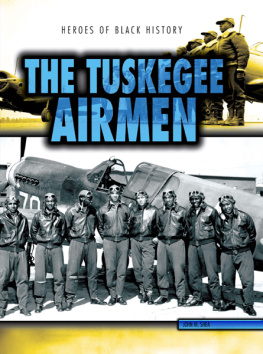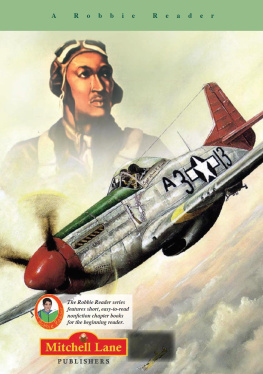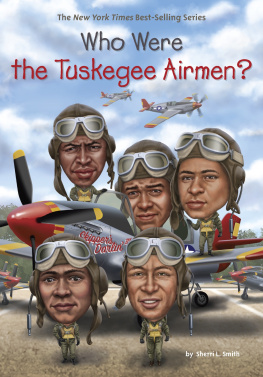
Please visit our website, www.garethstevens.com. For a free color catalog of all our high-quality books, call toll free 1-800-542-2595 or fax 1-877-542-2596.
Library of Congress Cataloging-in-Publication Data
Shea, John M.
The Tuskegee Airmen / John M. Shea.
pages cm. (Heroes of black history)
Includes bibliographical references and index.
ISBN 978-1-4824-2916-9 (pbk.)
ISBN 978-1-4824-2917-6 (6 pack)
ISBN 978-1-4824-2918-3 (library binding)
1. World War, 1939-1945Participation, African AmericanJuvenile literature. 2. African American air pilotsHistory Juvenile literature. 3. World War, 1939-1945Aerial operations, AmericanJuvenile literature. 4. Tuskegee Institute Juvenile literature. 5. United States. Army Air Forces. Fighter Squadron, 99thJuvenile literature. 6. United States. Army Air Forces. Fighter Group, 332ndJuvenile literature. 7. World War, 1939-1945Regimental historiesUnited States Juvenile literature. I. Title.
D810.N4S42 2015
940.544973dc23
2015007632
First Edition
Published in 2016 by
Gareth Stevens Publishing
111 East 14th Street, Suite 349
New York, NY 10003
Copyright 2016 Gareth Stevens Publishing
Designer: Katelyn E. Reynolds
Editor: Therese Shea
Photo credits: Cover, pp. 1 (Tuskegee Airmen), 5 Afro American Newspapers/Gado/Getty Images; cover, pp. 132 (background image) usaf/Wikipedia.org; p. 7 Marion Post Wolcott/Library of Congress/Getty Images; p. 9 PhotoQuest/Getty Images; pp. 11, 21, 23, 27 Library of Congress; p. 13 Time Life Pictures/US Signal Corps/ The LIFE Picture Collection/Getty Images; p. 15 Courtesy of the Franklin D. Roosevelt Presidential Library and Museum, Hyde Park, New York; p. 17 Office of War Information/Wikipedia.org; p. 19 National Archives and Records Administration, College Park/Wikipedia.org; p. 22 U.S. Air Force/Wikipedia.org; p. 25 (both) Max Haynes - MaxAir2Air.com/Wikipedia.org.
All rights reserved. No part of this book may be reproduced in any form without permission in writing from the publisher, except by a reviewer.
Printed in the United States of America
CPSIA compliance information: Batch #CS15GS: For further information contact Gareth Stevens, New York, New York at 1-800-542-2595.
CONTENTS
PROVING THEM WRONG
They flew over North Africa, the Mediterranean Sea, and Europe. They shot down the fastest jet planes flown during World War II. They protected American planes from some of the best, most dangerous fighter pilots in the world.
The Tuskegee Airmen, the first US black military pilots, joined the cause to fight enemy forces during World War II. But they fought another war as well: the one against prejudice and racism among their fellow Americans. At a time when many white Americans thought blacks werent skilled or brave enough to join the military, the Tuskegee Airmen risked their lives proving them wrong.
FIRST IN FLIGHT
The Tuskegee Airmen were the first black military pilots in the United States, but they werent the first African Americans to get pilot licenses. Emory Malick of San Diego, California, received his license in March 1912. Because no one would teach a black woman to fly in the United States, Bessie Coleman traveled to France to earn her license in 1922.

We proved that the antidote to racism is excellence in performance, said Tuskegee Airman Herbert Carter. With their courage and accomplishments, these men would forever change the American military.
SEGREGATION
About 179,000 blacks had joined the Union army of the North to fight for their freedom by the end of the American Civil War (18611865). In 1868, the Fourteenth Amendment to the US Constitution gave blacks their American citizenship and equal protection of the laws. However, true equality wouldnt be guaranteed until much later.
By the late 19th century, segregation was common practice across the nation. This meant the separation of blacks and whites in places such as schools, workplaces, restaurants, libraries, and even the military. There was a racist belief among military leaders that blacks shouldnt be placed in combat, or armed fighting, because they were harder to instruct and less brave than white soldiers.
JIM CROW LAWS
From the 1880s to the 1960s, many states had laws that enforced segregation. These Jim Crow laws outlawed marriage between blacks and whites and forced many businesses to segregate, or separate, their white and black customers. One law in Georgia even made it illegal for white and black baseball teams to play within two blocks of each other!
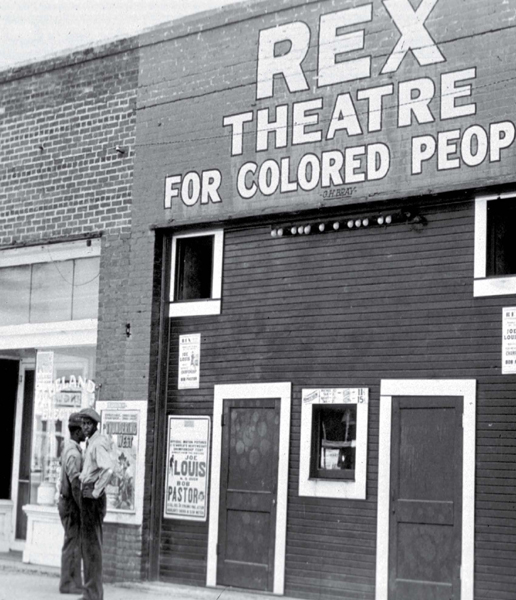
Some Jim Crow laws required separate buildings for whites and blacks, such as this black-only movie theater in Mississippi.
WORLD WAR II BEGINS
In 1939, long-standing uneasiness between European nations erupted into a violent conflict: World War II. At first, many Americans were unwilling to join what they saw as a European war. But on December 7, 1941, the Japanese bombed Pearl Harbor in Hawaii. The next day, the United States declared war on Japan. In turn, Germany and Italy, Japans allies, declared war on the United States.
Americans were now eager to go to war. Recruitment into the armed forces after the bombing was the highest in American history. Blacks joined the army, too, but military segregation limited their duties to mostly unskilled tasks such as cooking and grave digging.
AXIS AND ALLIES
The three main countries of the Axis powers of World War II were Germany, Italy, and Japan. Other countries joined them. Their goal was to expand the territories they controlled. The Allieswhich included Great Britain, China, the United States, and the Soviet Unionfought to stop the Axis and establish worldwide peace.
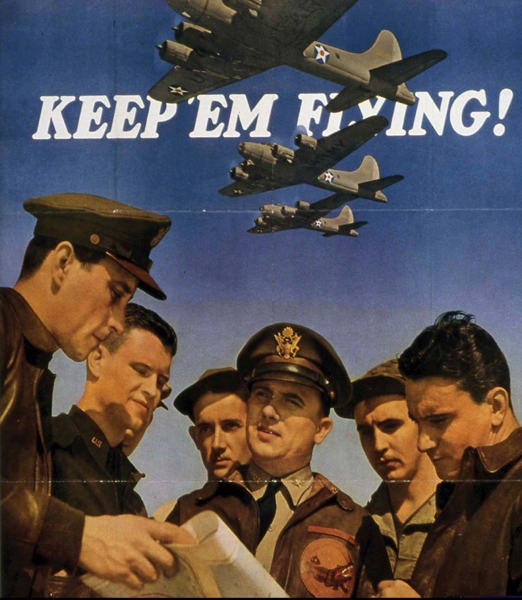
After the Japanese attack on Pearl Harbor, US armed forces called men and women to sign up to fight back. African Americans were eager to join, but werent given the same opportunities as whites.
THE CIVILIAN PILOT TRAINING PROGRAM
Even before Japans attack on Pearl Harbor, some American leaders were preparing for war. Aware of how important air power would be in future conflicts, President Franklin D. Roosevelt signed the Civilian Pilot Training Program in 1939. This established flight schools to rapidly increase the number of American pilots. The program worked: when the United States entered World War II, the number of American pilots had already increased from 31,000 to 100,000 within 18 months.
In 1939, Public Law 18 called for the Civil Aviation Authority to train African Americans as pilots. Tuskegee Institute in Alabama was chosen as the first school for these trainees.
TUSKEGEE INSTITUTE
Since most blacks couldnt attend schools with whites, African Americans were forced to create their own. In 1881, Lewis Adams, a former slave, and George Campbell, a former slave owner, helped establish a school for black teachers in Alabama, later called Tuskegee Institute. Booker T. Washington, the schools first principal, helped recruit highly educated blacks to teach there.

